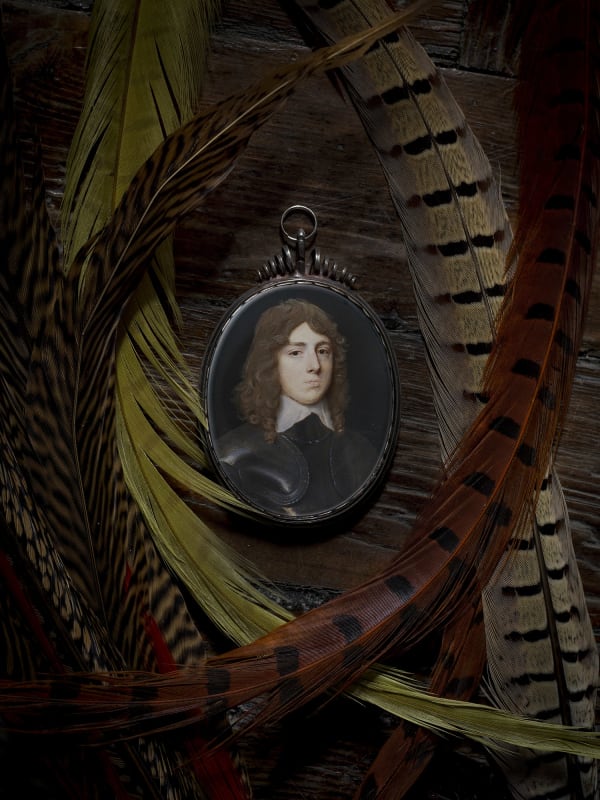Full Biography
The leading portrait miniaturist and one of the most successful artists in Regency England, Richard Cosway was the only child of Devonshire based schoolmaster and his wife, Richard and Mary Cosway, living in Oakford near Tiverton.
Even as a child Cosway displayed his propensity for drawing and by the age of twelve had already begun working in London under famous portrait artist[1] , Thomas Hudson, soon leaving to attend the drawing school the Society for the Encouragement of Arts, Manufactures, and Commerce, set up on the Strand by portraitist, William Shipley. Adamant to fulfil his ambition ‘to be someday the greatest artist in London’, Cosway devoted extensive time to refining his meticulous technique, and Shipley’s inherently philanthropic nature and pervasive influence on London’s artistic elite proved highly beneficial for the young artist.[1] In 1755, an ambitious Cosway took first prize at the Society’s annual ‘under-fourteens’ competition, relegating his future rival, John Smart, to second place.
The leading portrait miniaturist and one of the most successful artists in Regency England, Richard Cosway was the only child of Devonshire based schoolmaster and his wife, Richard and Mary Cosway, living in Oakford near Tiverton.
Even as a child Cosway displayed his propensity for drawing and by the age of twelve had already begun working in London under famous portrait artist[1] , Thomas Hudson, soon leaving to attend the drawing school the Society for the Encouragement of Arts, Manufactures, and Commerce, set up on the Strand by portraitist, William Shipley. Adamant to fulfil his ambition ‘to be someday the greatest artist in London’, Cosway devoted extensive time to refining his meticulous technique, and Shipley’s inherently philanthropic nature and pervasive influence on London’s artistic elite proved highly beneficial for the young artist.[1] In 1755, an ambitious Cosway took first prize at the Society’s annual ‘under-fourteens’ competition, relegating his future rival, John Smart, to second place.
Cosway exhibited oils, miniatures and drawings at the Society of Artists, winning numerous prizes, whilst continuing to learn from Reynolds and Hudson. Understanding that the location for his studio was to be part of his success as a society artist, in 1768 he took up residency in London’s fashionable Piccadilly, at 4 Berkeley Street. Over the next two years, Cosway completed his signed self-portrait[2] and was accepted into the Royal Academy Schools and in 1770 became an associate and later a full academician, exhibiting his work until 1806.
Cosway enjoyed a long friendship with the Prince of Wales, later King George IV. As an experienced connoisseur and virtuoso, Cosway advised the prince on his art collection, thereby sculpting his aesthetic taste. The relationship was most certainly mutually beneficicial, with the prince introducing Cosway to a fashionable and influential circle of patrons.[2] In 1785 Cosway was given the official position of ‘Miniature Painter to the Prince of Wales’, a post he kept until he fell out of favour in 1811.
Cosway had married the Anglo-Italian artist Maria Cosway[3] , née Hadfield, in 1781 and the pair had one child, Louisa Paolina Angelica, who tragically died in 1796 after a short illness. The Cosways wielded great influence over London's fashionable elite and from 1784 established a salon at their home at Schomberg House, Pall Mall, which also displayed their impressive collection of old master paintings, drawings, prints, furniture, sculptures and other objets d’art.
In 1791 Cosway moved to Oxford Street and then to Edgware Road in 1821. As his style matured, he began working on larger ivories, employing his distinctive stylistic traits such as the enlargement of the eyes and head in relation to the body which lent his portraits an alluring charm. A variety of Cosway’s portrait miniatures are included in our artworks section below, some are notable sales whilst others are for sale, available to buy[4] . He developed a technique which contrasted delicate stipple work in the face with more fluent, expressive brushwork in the body and background. Other identifiable characteristics include the ‘Antwerp blue’ frothy skies and by ‘floating’ his watercolour pigments on the pale ivory surface he allowed the luminous transparency of the material to suggest the natural glow of light.[3] His confident draughtsmanship demonstrated in small, full-length portraits in watercolour and graphite called ‘tinged’ drawings, influenced the likes of Henry Edridge A.R.A. and George Chinnery, and his legacy is manifest in the work of his students Nathaniel and Andrew Plimer, as well as miniaturist disciples Charlotte Jones, William Wood and Anne Mee.
Cosway continued to produce miniatures into the early nineteenth century, and although his later life was plagued with illness (he suffered partial paralysis following a stroke), his work stands as testament to his significant contribution to the development of the genre. He eventually died in 1821 leaving a decisive mark on the history of British portraiture.
A number of Richard Cosway portrait miniatures are pictured above, these include some significant acquisitions, sales and available works from Cosway. Philip Mould & Company have acquired and sold a number of important portrait miniatures including A Young peeress possibly Anne Montgomery (c. 1752-1819) and her brother (possibly) her half brother George Montgomery, Miniature Portrait of a Midshipman and Portrait Miniature of Harry Powlett, 6th Duke of Bolton.

















